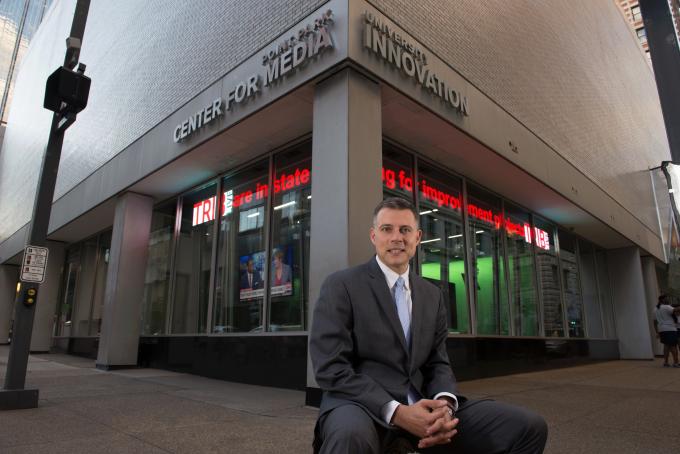New Center For Media Innovation Educates Tech-Savvy Journalists

The Point
Fall 2016
With the official opening on Sept. 13 of the Center for Media Innovation, Point Park is taking a leading role in educating a new generation of media professionals.
The Center also positions the University as an important resource for professional journalists and as an advocate for helping the public-at-large understand the critical role of strong, independent media in society today.
Modern Media Hub
"The media industry has evolved beyond individual labels such as print and television. Young journalists must be prepared for a massive multimedia effort that requires knowledge and expertise in multiple disciplines," said Andrew Conte, director of the Center for Media Innovation and an award-winning investigative journalist in his 15 years at the Pittsburgh Tribune-Review. "The Center for Media Innovation is designed as an incubator and collaborative space that brings together a cohesive, interactive strategy to education."
Related Links
The Center's floor-to-ceiling glass walls, flat-screen televisions and a digital ticker offer a New York City-style media hub where passersby can be entertained and informed as students learn their craft.
"Point Park has spent the last decade bringing activity to its street-level spaces along Wood Street, Boulevard of the Allies and Forbes Avenue," said Paul Hennigan, president of the University. "The Center is uniquely designed to showcase the vibrancy of the educational opportunities we offer our students while providing the public a visually engaging experience."
New Media, New Tools
While the Center will be a relevant educational tool for students of all schools at Point Park, the goal is to reach beyond University walls. "This is a major investment in supporting journalism at a time when the industry needs it the most. Along with training a new generation of journalists, we will offer opportunities to professionals looking to sharpen skills and add new ones, as they work to keep up with industry changes," Conte said. "The general public also will be welcome to attend events designed to teach them about media and the vital role it must continue to play in their daily lives."
Designed by Pittsburgh-based GBBN Architects, the 4,000-square-foot center cost $2.5 million to build and has been made possible, in part, with a grant from the Allegheny Foundation. Trib Total Media is a sponsor of the Center's news ticker.
The Mission of the Center
- Training: The Center will engage current students, high school students, professionals and citizens in learning journalistic skills and values.
- Outreach: The Center will serve as a clubhouse for journalists, with frequent events for professionals, opportunities for students and prospective students, and national aspirations for recognizing industry leaders.
- Online presence: The Center will have a digital presence as compelling and interesting as the physical space. The online site will include podcasts, a video library, news stories and a blog, with robust social media components.
Inside the Center
- TV and radio broadcast studios: The television studio includes a green screen, industry-specific lighting, and high-definition cameras. The radio broadcast booth shares a common control room. Both broadcast areas are be self-contained modules with high-visibility glass walls for a "fishbowl" studio experience.
- Photo studio: The studio features high ceilings and light control for the best possible shooting environment.
- Multimedia newsroom: Reporting and multimedia storytelling, along with graphics production, social media, and website and page layout can be conducted through multiple courses in this high-tech smart classroom.
- Transformational presentation and gallery space: The Center can transform into an event space for networking and educational sessions with newsmakers and industry leaders. The area can be used as a photo gallery, offering another space for students to showcase work.
By the Numbers
- The 17-foot-by-15-foot pivot wall and folding glass partitions allow three rooms to become one large space.
- Three miles of data cabling has been installed in the Center.
- There is a three-degree angle tilt to the glass walls in the television studio to help reflect sound and light waves.
- Four-inch acoustic foam insulates the walls in the radio studio.
- A one-inch foam padding system in the studio floors absorbs sound in the space and prevents exterior noise.
- Fourteen televisions of various size are installed throughout the space.
Text by Lou Corsaro
Photo by John Altdorfer
The Point is the magazine of Point Park University

